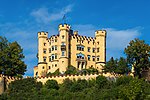Tegelberg Cable Car
Cable cars in GermanyTransport in Bavaria

The Tegelberg Cable Car (German: Tegelbergbahn), on the Tegelberg mountain near Schwangau in southern Bavaria. The cable car is 2,146.18 metres long, climbs a height of 892.5 metres, has a carrying cable of 48 mm in diameter and a hauling cable of 26 mm in diameter. It has two cabins each capable of transporting up to 44 persons. They are driven by a 2,540 KW engine. The cableway has a 38 metre high support pillar, made of reinforced concrete.
Excerpt from the Wikipedia article Tegelberg Cable Car (License: CC BY-SA 3.0, Authors, Images).Tegelberg Cable Car
Tegelbergstraße,
Geographical coordinates (GPS) Address Nearby Places Show on map
Geographical coordinates (GPS)
| Latitude | Longitude |
|---|---|
| N 47.567777777778 ° | E 10.756666666667 ° |
Address
Tegelbergstraße 35
87645
Bavaria, Germany
Open on Google Maps











